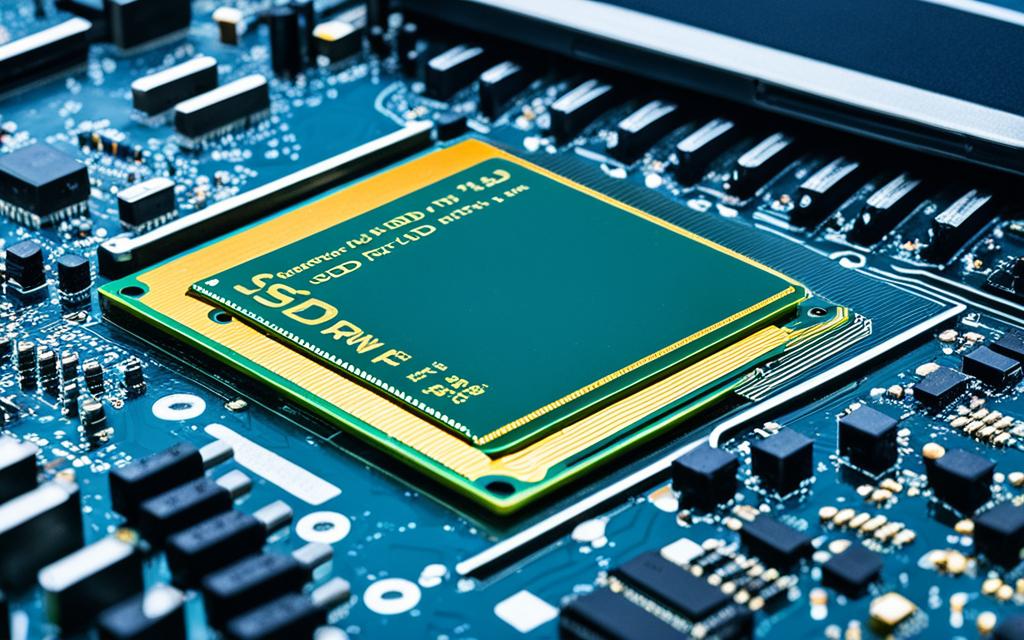Table of Contents
Formatting an SSD is key to keeping it working well and lasting longer. This process returns your drive to a fresh state, like when you first bought it. By doing this, you make sure it works at its best and safely remove any old data. This is really important if you’re thinking of selling or giving away the SSD. Opting for a Quick Format is smart because it reduces unnecessary wear on the drive1. Making the right choices here means your SSD will work smoothly, deliver a great experience, and last longer. In this guide, we’re going to explore how to format an SSD on Windows 10. We’ll look at helpful tips, tricks, and some common problems you might run into.
Key Takeaways
- Formatting an SSD can significantly enhance its performance, similar to a reset.
- Utilising Quick Format helps avoid unnecessary read/write cycles.
- Backing up data is crucial before engaging in any formatting procedure.
- Choosing the correct file system, such as NTFS or exFAT, impacts your usage.
- Understanding the TRIM command is vital for maintaining SSD health.
- Securely erasing data ensures complete removal and protects sensitive information.removal and protects sensitive information.
- Post-formatting steps can further optimise your SSD’s functionality.
Understanding the Importance of Formatting an SSD
Formatting an SSD is key to keeping it running well. It helps boost SSD performance by removing old files. This sets the stage for managing data better. Sometimes, people forget how vital regular maintenance is, especially for efficiency in SSD use.
Benefits of Formatting for Performance and Efficiency
Formatting your SSD has manyreformatting benefits. It keeps your SSD working longer and quicker. Refreshing the system avoids data pile-ups that slow the drive down. Tools like Windows Disk Management can format SSDs well. This lets users make new sections and get the drive usage-ready2. Zero-filling also helps by deleting data completely, making it hard to recover2.
When to Consider Formatting Your SSD
Knowing when to format SSD helps maintain its speed. It’s good to do when adding a new operating system, like Windows 10. This prevents any setup problems. Formatting is also wise before upgrading SSDs or changing their purpose. This ensures old data stays private2. Regularly doing so keeps your storage tidy and well-performing.
SSD’s abilities are impressive, but they can weaken over time. Thus, formatting them regularly is crucial for good performance2. This is important for installing new systems or before selling the drive. It keeps your private information safe.
Preparing for SSD Formatting
Before you start formatting your SSD, make sure your data is safe. Backing up is key because formatting wipes everything. It’s vital to protect your important files well.
Backing Up Important Data
Backup your SSD data to keep your crucial files safe. Use external storage or cloud services for backups. These methods make data recovery easy, setting up a smooth formatting process.
Ensuring TRIM is Enabled
Good SSD performance relies on the TRIM command. TRIM tells the SSD which blocks of data are not used, improving its function. Check that TRIM is on in your settings or through command prompts. This step will make sure your SSD works well, even after formatting.
When it comes to SSDs, understanding the interplay between formatting and data management is vital. Proper preparation not only enhances user experience but also preserves the integrity of vital information.
| Backup Method | Description | Pros | Cons |
|---|---|---|---|
| External Storage Drive | Physical device used to store data | Reliable and fast access | Risk of physical damage |
| Cloud Storage | Online service for data storage | Access from any location | Requires internet connection |
Following these steps will keep your data safe and ensure a smooth change to your newly formatted SSD. This preparation leads to better performance later3.
How to Format a SSD Drive Windows 10
You can easily format an SSD drive in Windows 10 with the Disk Management tool. It’s user-friendly for all, whether you’re a beginner or more experienced. It’s crucial to follow the right steps whether you’re setting up the drive for new data or boosting its efficiency. Here’s a detailed guide for a hassle-free formatting process.
Using Disk Management Tool
To start, right-click the Start button and pick “Disk Management.” You’ll see all drives and their status. This formatting SSD tool lets you pick and configure your SSD easily. Using this tool makes the step-by-step SSD formatting process straightforward.
Steps to Follow for Formatting
To properly format an SSD in Windows 10, follow these steps:
- Open Disk Management and find your SSD.
- Right-click on it and hit ‘Format’ to see formatting options.
- Pick NTFS for internal SSDs, as it’s been standard since Windows 3.14. For external ones, exFAT is better for its versatility and lack of size limits4.
- Choose the allocation unit size that fits your needs.
- Tick the ‘Quick Format’ box. This method is less wearisome for your drive1.
- Press ‘OK,’ then confirm to begin formatting.
Following these steps will ensure your SSD is formatted correctly for best performance. Full formatting isn’t usually needed for SSDs, thanks to TRIM support keeping them swift1.
Choosing the Right File System for Your SSD
When you format your SSD, picking the best file system is key for the best speed and fit. Different file systems serve various purposes as technology moves forward. Looking closely at a file system comparison shows important differences. These differences greatly affect how well applications run and the user’s overall experience.
Comparing Common File Systems: NTFS, exFAT, and FAT32
NTFS, exFAT, and FAT32 are the main choices for SSD formatting. Launched by Microsoft in 1993, NTFS is ideal for internal SSDs in Windows 10. It supports file compression and security. It’s often seen as the best file system for SSD because of its superior local application performance and ability to handle large files5.
On the other hand, exFAT is popular for external drives since its 2006 introduction. It works well with different systems, including macOS, making it perfect for handling large files over 4GB. This makes it a good pick for SSDs used in various operating systems5.
FAT32 is older and can’t deal with files larger than 4GB. This limit makes it less useful today4. However, its broad compatibility is a plus. The trade-off is less flexibility and speed.
Implications of Each File System for Your Usage
Knowing the effects of each file system helps in making the most of your SSD. NTFS is best for Windows internal use. ExFAT is top for use between Windows and macOS5. NTFS also outpaces others in speed, important for demanding applications5.
Before using SSDs on different systems, formatting is recommended. A big majority, 70%, of new SSD users do it for compatibility between systems6. While 60% format an SSD before selling to stop data leaks. The choice mainly depends on personal needs and where the SSD will be used. A well-thought-out decision leads to the best performance without facing limit.
Securely Erasing Data on an SSD
Many users worry about keeping their data safe on SSDs. It’s vital to know how secure erase and formatting differ. Formatting makes an SSD ready for new data but may not hide old data well. A proper secure erase SSD method wipes all data, leaving no trace behind.
Understanding Secure Erase vs. Formatting
Formatting prepares a drive for new use but might not clear all old data. Secure erase fully removes data, ideal for keeping personal info safe. Since SSDs balance memory use, secure erase is less harsh than formatting and keeps the SSD in better shape7. Windows 10’s diskpart utility allows for free secure erases7.
Tools for Securely Wiping Your SSD
Many tools help securely wipe SSDs for all skill levels. SSD makers like Samsung and Kingston offer software with secure erase features7. Third-party Parted Magic is well-respected, starting at $15 for thorough disk cleaning8. These tools ensure data stays confidential and are trusted by many.
Common Issues and Troubleshooting Tips
Formatting an SSD can sometimes feel daunting due to various common SSD problems. Users may face drive recognition errors or struggle to find the formatting options. First, check all connections are secure and that the SSD isn’t write-protected. You might need admin permissions, as accessing crucial settings can be restricted. Looking at the system logs can shed light on formatting issues SSD, aiding in troubleshooting SSD format.
Addressing Problems During the Formatting Process
During formatting, issues like physical damage and malware may arise. These problems can stop Windows from formatting the device, especially if it’s locked or if there are file system errors like Linux Ext2/3/4 or RAW format9. To overcome these, try using Diskpart in Command Prompt. Ensure there’s no write protection, bad sectors, or other hurdles before trying to format again.
Post-Formatting Steps to Take
After formatting an SSD, take some post-formatting steps for the best performance. First, make sure the file system is set up right for how you’ll use it. It’s vital to check if the TRIM command is active for SSD health, and updating firmware can make the drive last longer. Finally, double-check the backup you made before formatting. This ensures you’re ready for data recovery if needed. These steps are key for maintaining your SSD and preparing for future use.
| Common SSD Problems | Potential Solutions |
|---|---|
| Write Protection | Disable using Disk Partition Utility |
| Bad Sectors | Run disk check utilities to repair |
| Corrupted File System | Use Diskpart command to attempt a reformat |
| Malware Infection | Run antivirus scans and removal tools |
| Physical Damage | Consult professional repair services |
Following these steps will help users tackle their troubleshooting SSD format problems. This ensures a smoother use of their SSD moving forward10.
Conclusion
Understanding how to format an SSD correctly is key to getting the best out of your storage. Doing it right can make your SSD work faster and store data more effectively. This makes your computer react quicker. It’s vital to keep your SSD in good shape. You need to know about file systems and make sure TRIM is on. Also, it’s important to erase data safely when needed.
Knowing the best time to format your SSD helps avoid problems like blue screen errors. These often happen if things aren’t done properly11. You can fix these problems by using trusted tools. Tools like AOMEI Partition Assistant or EaseUS Partition Master help with formatting1213. With the right knowledge and tools, formatting your SSD becomes easy. This is the first step for setting up your device for new data.
As technology advances, we should also update how we manage our storage. Regular maintenance, such as SSD formatting, boosts your device’s performance. It ensures it can handle your computing needs as they change. Keep these points in mind about SSD formatting. They can help you manage your digital space better. This leads to a smoother and more efficient use of your computer.
FAQ
What is the process for formatting an SSD on Windows 10?
To format an SSD on Windows 10, start with the Disk Management tool. Choose your SSD by right-clicking on it. Then, select ‘Format’, pick NTFS for the file system, and tick Quick Format. This method is quick and keeps your SSD in good shape.
Why should I format my SSD?
Formatting your SSD makes it work better because it removes old data. This makes your device faster and organises data more efficiently. It’s also key for adding new operating systems or wiping your data when giving the SSD away.
How often should I consider formatting my SSD?
Think about formatting your SSD when you’re adding a new operating system or updating your SSD. If your device starts to slow down, formatting might help. Doing this regularly helps keep your SSD running smoothly.
What precautions should I take before formatting an SSD?
Make sure to back up your files to avoid losing anything important. Use an external drive or cloud storage for safety. Also, make sure TRIM is on to get the best performance from your SSD.
How can I enable TRIM on my SSD?
Check if TRIM is active by using a command prompt or in system settings. Use “fsutil behavior query disabledeletenotify” to see if it’s on. If not, turn it on with “fsutil behavior set disabledeletenotify 0”.
What are the differences between NTFS, exFAT, and FAT32 when formatting an SSD?
NTFS is best for Windows SSDs because it can handle big files and has strong security. exFAT works with many operating systems, good for external drives. FAT32 is compatible but can’t handle files over 4GB, which isn’t great for big files.
What tools can I use for securely erasing an SSD?
You can use special tools for erasing an SSD safely. Look for tools from your SSD’s manufacturer, like Crucial or Kingston. There are also third-party options that fully clean your SSD.
What should I do if I encounter issues while formatting my SSD?
If formatting doesn’t go smoothly, check the SSD’s connections and make sure you have admin rights. Also, ensure the drive isn’t write-protected. For more help, turn to system logs or get support from Windows.
What steps should I take after formatting my SSD?
After formatting, check that the SSD’s file system and TRIM are set up correctly. Then, go ahead with installing your software as planned. Updating your SSD’s firmware might also be a good idea to keep it running well.
Source Links
- https://www.crucial.com/articles/about-ssd/how-to-format-a-solid-state-drive – How to Format a Solid State Drive (SSD)
- https://www.digitaltrends.com/computing/how-to-format-ssd/ – How to format an SSD to improve performance and privacy | Digital Trends
- https://www.partitionwizard.com/partitionmagic/how-to-format-ssd.html – 3 Different Ways to Free Format SSD with No Harm to SSD – MiniTool Partition Wizard
- https://www.howtogeek.com/803510/how-to-format-an-ssd-on-windows-10/ – How to Format an SSD on Windows 10
- https://www.diskpart.com/articles/ntfs-or-exfat-for-ssd-7201.html – NTFS or exFAT for SSD? Which Format is Better for SSD?
- https://www.easeus.com/partition-master/format-ssd-windows-10.html – SSD Format Tool: How to Format SSD for Windows 10 Install (Mac Installation Available)
- https://www.tomshardware.com/how-to/secure-erase-ssd-or-hard-drive – How to Securely Erase an SSD or HDD Before Selling It or Your PC
- https://www.backblaze.com/blog/how-to-wipe-pc-ssd-or-hard-drive/ – How to Wipe a Windows PC SSD or Hard Drive
- https://community.wd.com/t/windows-10-cant-format-my-drive/280189 – Windows 10 can’t format my drive
- https://recoverit.wondershare.com/format-hard-drive/format-ssd-drive.html – How to Fix All SSD Problems on Windows and Mac
- https://www.diskpart.com/articles/ssd-will-not-format-0310.html – Solved: SSD Won’t Format in Windows 11, 10, 8, 7 (Four Solutions)
- https://www.easeus.com/partition-master/format-ssd-with-windows-on-it.html – How to Format SSD with Windows on It? [Windows 11/10/8/7]
- https://www.diskgenius.com/how-to/reformat-hard-drive.php – How to Reformat Hard Drive in Windows 10/8/7?








